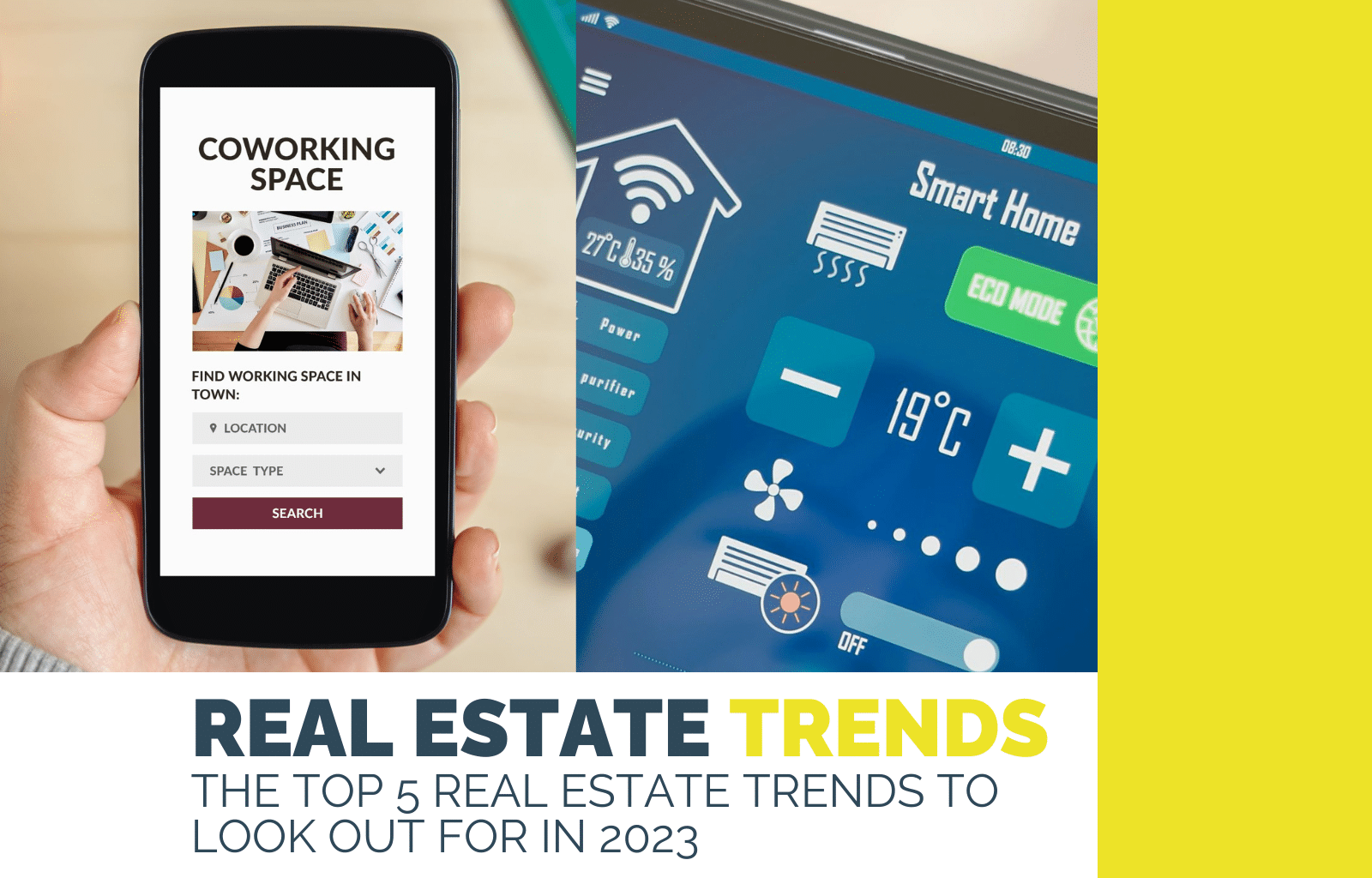Real Estate Trends
The real estate market is cyclical. It is divided into four phases: recovery, expansion, hyper-supply, and recession. It can provide reliable information regarding an investment property’s potential profit.
For investors, it is crucial to identify in which phase of the real estate cycle we are at the time of investment. This will help the investor understand how long a property will need to be held and the best exit strategy because they can better forecast an investment property’s income and appreciation outlook.
As we begin the new year, it is crucial to look forward and plan for 2023 based on the top real estate trends.
Top 5 Real Estate Trends of 2023
Any recurring pattern or shift in the real estate market’s direction that, over time, results in a statistically significant change is referred to as a sector trend. The economy, a shift in mortgage rates, consumer speculation, or other fundamental and non-basic factors may be responsible for this occurrence.
These trends significantly impact the value of the investment property. Let us learn about 5 new real estate trends in 2023.
1. The Transition to Smart Buildings
There has been a shift in favor of intelligent buildings in recent years. The term “smart building” refers to a building that uses cutting-edge technology to improve operational effectiveness, occupant comfort, and energy efficiency.
Smart buildings have various advantages, including less energy use, cheaper operating costs, and increased tenant satisfaction.
Smart buildings also have certain drawbacks, including a costly initial investment and the requirement for qualified employees to run and maintain the systems. Despite the difficulties, as technology becomes more accessible and less expensive, the trend toward intelligent buildings is likely to continue.
The Internet of Things (IoT) and its related devices, such as environmental and lighting controls, data collection systems, and augmented reality experiences, are often managed from a single panel in a smart building.
These innovations make buildings more user-friendly and minimize the facility’s carbon footprint. The global smart building market is expected to increase at a CAGR of 22.2% from $80.62 billion in 2022 to $328.62 billion by 2029.
Today looking for a home has become digital. People who seek to rent want the option of a virtual tour; virtual staging has become a popular method to showcase apartments.
2. The Development of Proptech
Proptech, or property technology, refers to all the technological tools that real estate professionals utilize to improve how people function within the real estate investment world. It is also known as Real Estate Tech, Retech, Realtech, and CRE Tech.
Variables, like the advent of a sharing economy, online property portals, and data analytics expansion, are fueling this. Proptech is altering how the real estate sector functions, including how properties are displayed and marketed and how they are managed and maintained. New technologies continue to develop, real estate technology trends should not be ignored.
Some of the most recent Proptech developments include the use of AI and data automation, big data and digitization of property data, sustainable technology in building and maintenance, and IoT with drones for 360-degree presentation. The PropTech Market is growing at a CAGR of 16.8%, reaching $86.5 billion by 2023.
Residential Property Tech refers to all of the digital solutions created by real estate technology companies to make it easier for customers to find and deal with housing.
Real estate technology trends have altered residential landlord-tenant interaction. Examples:
- Detailed 24/7 insights into how renters use the property, enabled via smart devices and sensor networks (IoT).
- Improved communication tools.
- The IoT world has no geographical boundaries. Inspections, tours, etc. are moving to the virtual realm, allowing landlords and tenants to do so from wherever convenient.
3. The Development of Co-Living
Another real estate trend is younger people, especially in urban gateway cities are increasingly opting for co-living environments with smaller units and shared communal spaces like kitchens and entertainment spaces.
For starters, renting a co-living space is frequently less expensive than doing so for a standard apartment. Additionally, they provide a sense of solidarity and community that can be advantageous for those new to a place or who wish to establish friends. Lastly, compared to traditional housing, co-living spaces are typically more environmentally friendly.
4. The Growth of Sustainable Development
To achieve climatic and environmental sustainability goals, the real estate sector can play a significant role, especially by utilizing the latest real estate technology trends. Governments and communities must continue to develop and adopt comprehensive, long-term policies that will encourage real estate investors to work together and support such efforts.
Environmentally friendly design techniques, materials, and technologies are more and more prevalent in the latest real estate trends. Instead of employing materials and tactics that raise a property’s carbon footprint, sustainable real estate development tries to lessen the environmental impact of a specific property, from the materials used to daily operations. This allows homes to cut operating costs while also helping the environment.
For nearly three decades, the Green Building Council has encouraged more efficient development through LEED, its building sustainability standard. Investors can ensure that they are investing in a green property by:
- Buying properties with LEED certification
- Buy and renovate or repurpose older buildings to environmentally friendly standards
5. The Growth of Coworking Facilities
When it comes to the latest real estate trends a brand-new business model is emerging in the global real estate market. Coworking spaces, on-demand workplaces, shared offices, etc., are some of the titles used to refer to this paradigm.
Due to rising real estate expenses and the ability to work from anywhere, this workspace paradigm has gained momentum. It is also beneficial for businesses that want a more flexible cost structure rather than being bound by long-term lease obligations.
Wrapping up Real Estate Trends
These are some of the emerging real estate trends that will be at the forefront of the market with real estate technology trends leading the way. Residential property investors should partner with property managers who are incorporating the latest real estate technology trends.
Summerfield is one such company we have firmly embraced and incorporated the latest real estate technology trends, and it is benefiting our clients in the form of higher annual returns on investment.
We would love to connect and share how we can help with your property!
Real Estate Trends: FAQs
Q: What impact does sustainability have on real estate?
A: Instead of employing materials and tactics that raise a home’s carbon footprint, sustainable real estate development tries to lessen the environmental impact of a specific property, from the materials used to daily operations.
Q: What are the fundamental elements of a smart building?
A: There are four of them: IoT sensors, analytics software, cloud-based user interface, and a connection method.
Q: What are the benefits of real estate technology for the residential investor?
A: There are many, here are a few,
1. It allows for streamlined communication with prospects, residents, and vendors
2. Payment Automation
3. Property condition monitoring
4. Virtual Tours, etc.










